For Thai people, the ancient capital of Sukhothai is a city forever associated with light, for this was where the sun rose on the Kingdom of Thailand. And the principles, on which the city was founded, still set a shining example of good governance for the modern Thai state.
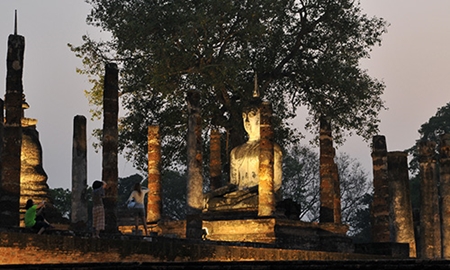
As evening comes the Sukhothai ruins are illuminated by floodlights.
Over 700 years ago, Sukhothai (the kingdom lasted from 1238 until 1438) was at the heart of a thriving nation, and it was during this golden age that so many of the traditions and festivals that we see as uniquely Thai first emerged like the Thai alphabet, the propagation of Theravada Buddhism, the ideals of kingship and politics, and the lovely festival of lights, Loi Krathong, which is celebrated to this day.
The kingdom of Sukhothai marks the very beginnings of the nation now known as the “Land of Smiles”. So, rather aptly, Sukhothai itself actually means “Dawn of Happiness”.
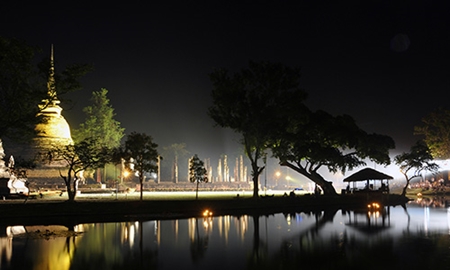
The sound and light show takes place around the Ceylonese stupa of Wat Sa Sri.
The temples and ruins of this city of dawn, now a UNESCO World Heritage Site, are the perfect venue for the Tourism Authority of Thailand’s (TAT) mini-light and sound show, which aims to offer illumination to tourists and bring to light some of the history and culture of this ancient city. There will be one show a month between February and September held at the lovely temple of Wat Sa Si in the heart of the historic site.
Light shows are nothing new to Sukhothai. During the annual Loi Krathong festival, which takes place around the full moon of the 12th lunar month (usually November), the historical park is home to the biggest show of the year when people come from all over the nation to see the ancient temples lit up by thousands of candles.
The mini-shows are not quite as epic in scale as the Loi Krathong shows in November, but they have a more intimate feel. Before you head to the evening show, you really should take a stroll around some of the other temples in the park. Dusk is the best time to be here and with the sun below the horizon things start to cool off and most of the major temples are atmospherically illuminated.
But don’t dawdle for too long. You need to get to the show well before 7 p.m. because once the show starts you can’t get onto the main Wat Sa Si island and you have to watch from the sidelines.
The historical buildings themselves form the backdrop to the show, as the performers play out the story of Sukhothai around the large bell-shaped stupa of Wat Sa Si, which shows influences of Sinhalese or Sri Lankan aspects of Buddhism.
It is a lovely setting to be sure but to make room for the theatrics, most of the audience has to take their place on the little island just adjacent to the temple grounds to watch the show. This brings its own problems as perched on the island, you feel just slightly too far from the action. And there is a limit to how many people get prime seats. If you are planning a visit, a pair of binoculars would really help you enjoy the background action.
The show begins with Thai classical music that seems to echo from the buildings themselves and provides an epic start to the show. This naturally starts with the foundations of the Sukhothai Kingdom, when two brothers, Pho Khun Bangklanghao and Pho Khun Phameung took Sukhothai from Mon hands in 1239. We are treated to epic fights skillfully reenacted and illuminated by pyrotechnics, so you do get to see the sparks fly with breathtakingly choreographed sword fights.
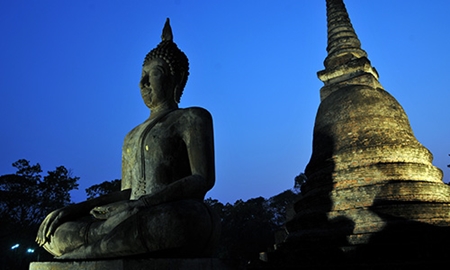
The ancient monuments of the city become part of the show
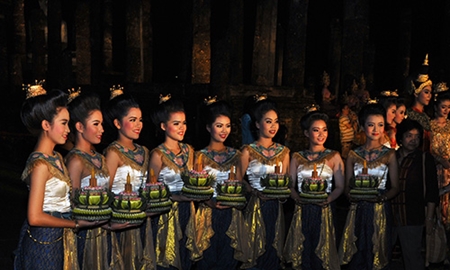
The lovely ladies of Loi Kratong in traditional costumes
Sukhothai has been the scene of many battles over the centuries but the city’s greatest achievements were in times of peace when King Ramkhamhaeng the Great was on the throne. King Ramkhamhaeng the Great, who ruled from 1278 to 1298 when the city was at its most prosperous, is the most important figure in the history of the Sukhothai era. He was said to have invaded the city with his father to take it back after it had briefly been a vassal state of the powerful Khmer. His bravery won him the title “Great”.
It was King Ramkhamhaeng the Great who Thai people believe was responsible for creating the Thai alphabet and who firmly established Buddhism as the state religion of the flourishing kingdom. Of course all this is far back in the mists of time and scholars are not sure of the real facts, but there is no doubt that his reign was one of great stability and prosperity. It was a time when arts and literature flourished, and these are just a few of the achievements celebrated in the light and sound show.
The audience watches war make way for peace and enjoy scenes of dancing and celebration. Dance plays a large part in the mini-light and sound show, as it was during the Sukhothai period that many of the best-known Thai dances were created and the movements formalised.
Eagle-eyed visitors will note how many of the dancers’ movements and positions echo those seen in the religious art of the period. The costumes and headdresses too are similar to those seen on the celestial beings carved into reliefs up and down the country. In fact it is the costumes that are one of the stand-out elements of the show, and it is worth taking a closer look when the evening comes to an end and you can meet the performers and have your picture taken with them as an extra memento of the visit.
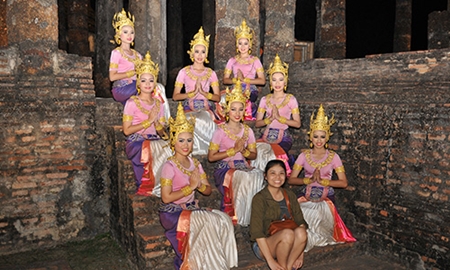
Pictures with the performers are a great way to remember the light show in Sukhothai.
This is the city of Ramkamhaeng the Great so he is, in many ways, the star of the show, appearing splendidly on the raised platform of the temple. As he does so, a series of fire-fueled lanterns (known as khom fai) rise from behind the mighty stupa of Wat Sa Si and gently rise into the sky like a spiral of light. This ancient method using light to mark special celebrations is perhaps even more impressive than the modern lights and lasers used in the rest of the light show.
The mini-show is a treat for the senses, pitched battles with flames and bangers give way to gentle displays of dancing and musical demonstrations of how Pha Sin Thin Chok cloth or Chinaware is made, both traditional products of the region. The show ends with homage to Loi Krathong itself, as the young female performers take their krathongs to the water’s edge, a reminder to visitors that the biggest show in November is yet to come.
Everyone who visits Sukhothai comes away impressed; the ruins are majestic, the town tranquil and the people welcoming, but this year, if you manage to catch the mini-light and sound show it really is the icing on the cake. In fact, it will probably be the highlight of your trip to this wonderful city of a happy dawn.
Sukhothai mini-light and sound shows in 2014 schedules
The first show took place on 22 February and the second show on 8 March.
The next mini shows will be held on 12 April, 10 May, 14 June, 11 July, 9 August and 13 September.
Admission to the show is free.
Sukhothai Historical Park is located 439.7 km north of Bangkok; about four-five hours by car or 1 hour 15 minutes by air.
For more images of the show, visit the TAT Newsroom Photo Library.
Republishing permission (click to read disclaimer)
Filed in : Features
Tags: Latestupdate




